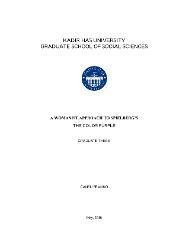| dc.contributor.advisor | Howlett, Jeffrey | en_US |
| dc.contributor.author | Franko, Cansu | |
| dc.date.accessioned | 2019-07-12T08:37:17Z | en_US |
| dc.date.available | 2019-07-12T08:37:17Z | en_US |
| dc.date.issued | 2016 | en_US |
| dc.identifier.uri | https://hdl.handle.net/20.500.12469/2126 | |
| dc.description.abstract | The present study focuses on the adapted 1985 film The Color Purple by Steven Spielberg The Color Purple. Set in the early 20th century United States the story is about the life and quest of a black woman Celie transforming herself from object to subject. it is a women’s story in which the experience is not limited to the main character but also includes the women around her. Silenced oppressed and insulted Celie is going through her journey of life struggling to find her voice. Once believing that the only way to survive in a world full of men pressure and abuse is to remain silent and be invisible Celie gains her voice and constructs her own narrative through the quest her life forces her to take. She finally manages to break her silence and to establish her own identity by freeing herself from the boundaries of her accumulative oppressive experience by men around her. in the following study the film will be analyzed by means of a womanist approach. in the course of my analysis i will first investigate feminist theory and then attempt to answer the question: why is Womanism the best theory to apply to a reading of the film? To support this contention certain scenes from the film will be analyzed to discuss how Steven Spielberg reflected this women’s story on the screen. The theories utilized to draw a frame are Gender studies Feminism and especially Womanism. | en_US |
| dc.description.abstract | Bu çalışma Steven Spielberg'ün 1985 yapımı adaptasyon filmi The Color Purple'a odaklanmaktadır. 20. Yüzyılın başlarındaki Amerika'da geçen film siyahi bir kadının nesneden özneye geçerkenki hayatını ve yolculuğunu konu almaktadır. The Color Purple yalnızca başroldeki karakterle sınırlı kalmadan, onun çevresindeki kadınların da hayatlarını içeren bir kadın hikâyesidir. Sessizleştirilen, baskılanan ve aşağılanan Celie sesini bulma yolculuğunda ilerler. Önceleri erkek baskısı ve istismarıyla dolu olan hayatında hayatta kalmanın tek yolunun sessiz kalmak ve görünmez olmak olduğunu düşünen Celie, hayatının onu zorla soktuğu yolculuğunda sesini kazanır ve kendi anlatısını inşa eder. En sonunda kendini etrafındaki erkekler tarafından yaratılan birikmiş baskılayıcı deneyimlerden özgürleştirerek sessizliğini kırmayı ve kendi kimliğini oluşturmayı başarır. Çalışma içerisinde film Womanist bir yaklaşımla incelenecektir. Analiz süresince önce feminist teori incelenmiş ve sonrasında neden feminizmin yanında Womanism teorisine ihtiyaç duyulduğu sorusuna cevap verilmeye çalışılmıştır. Fikri desteklemek için Steven Spielberg'ün bir kadın hikâyesini ekrana nasıl yansıttığı tartışılarak film içerisindeki belli başlı sahneler incelenmiştir. Bir çerçeve oluşturabilmek için Cinsiyet, Feminizm ve Womanism teorilerinden yararlanılmıştır. | en_US |
| dc.language.iso | eng | en_US |
| dc.publisher | Kadir Has Üniversitesi | en_US |
| dc.rights | info:eu-repo/semantics/openAccess | en_US |
| dc.subject | The Color Purple | en_US |
| dc.subject | Gender | en_US |
| dc.subject | Feminism | en_US |
| dc.subject | Womanism | en_US |
| dc.subject | Steven Spielberg | en_US |
| dc.subject | Mor Yıllar | en_US |
| dc.subject | Cinsiyet | en_US |
| dc.subject | Feminizm | en_US |
| dc.title | A womanist approach to Spielberg’s the color purple | en_US |
| dc.type | masterThesis | en_US |
| dc.department | Enstitüler, Lisansüstü Eğitim Enstitüsü, Radyo, Televizyon ve Sinema Ana Bilim Dalı | en_US |
| dc.relation.publicationcategory | Tez | en_US |
| dc.identifier.yoktezid | 429283 | en_US |
















